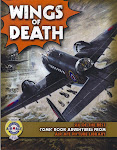 Just watched Comics Britannia, as I'm sure many of you have. I thought the whole thing was superbly handled and my initial worries from reading a couple of reviews were quickly forgotten.
Just watched Comics Britannia, as I'm sure many of you have. I thought the whole thing was superbly handled and my initial worries from reading a couple of reviews were quickly forgotten.In truth, this is not a series about the history of comics but three snapshots of certain aspects, the first show concentrating on The Beano and The Dandy when they were at their best. To show them at their bests, the producers concentrated on four artists -- Dudley D. Watkins, David Law, Leo Baxendale and Ken Reid -- and it would have been a real shocker if they'd screwed up with that line-up of talent. It was a joy to see the camera swooping in on pages of original artwork, complete with pencil lines on the word balloons and marked up in blue pen; the camera roved around the pages, as the eye would when reading a comic, blowing up the pages to ten times how we would normally see it. Sometimes that meant lots of colour dots (due to how the colour was printed back in the days of classic Beano and Dandy) but it bodes well for later episodes where we may see fully-painted originals of Dan Dare artwork. (Fingers crossed.)
There were a few quibbles, such as the implication that the Dandy created speech balloons and the statement that Dudley Watkins was the only artist at DCT allowed to sign his work*, but that's minor. Perhaps the biggest quibble is that humour comics beyond these four artists were rather dismissed out of hand: the stagnation at Thomsons was less to do with the implied lack of talent of the replacements, rather that the strips became formulaic, which seems to me the obvious result of artists being asked to work on other people's creations in a pre-set style (as happened with most of Leo Baxendale's creations) or trying to create new strips for a character thirty years out of date (Lord Snooty being perhaps the most guilty of this). Today we have Hunt Emerson drawing Little Plum and it's recognisably Hunt Emerson, not some third generation photocopy of Leo Baxendale, so the strip can be judged on whether it's funny or not on its own merits.
This aside, I thought the show was spot on: serious without being snobbish, accessible without being dumbed down. The interviewees tackled the racism of those early comics and the not-always-true "fact" popularised by journalists that all strips ended with a feast or a whacking (something Leo Baxendale denied, with evidence, in his book On Comedy). Overall the tone was of celebration. It walked a fine line between keeping fans happy and making it interesting and nostalgic mainstream viewing and as far as I'm concerned the series took its first strides confidently.
More information:
* Comics Britannia website at the BBC.
* Interview with Alastair Laurence at the Forbidden Planet International blog.
* Review by Charlie Brooker from The Guardian (8 September)
* Review by Kim Newman from The Times (8 September)
* Review by Lew Stringer at Blimey! (9 September)
* Review by James Walton from the Daily Telegraph (11 September)
* Review at TV Schoop (11 September)
* Review by Andrew Billen from The Times (11 September)
Related:
* Bryan Talbot's History of British Comics from The Guide (The Guardian, 8 September) is scanned at Rich Johnson's Lying in the Gutters.
(* I think I'm right in saying that Allan Morley also signed some of his work.)













































































